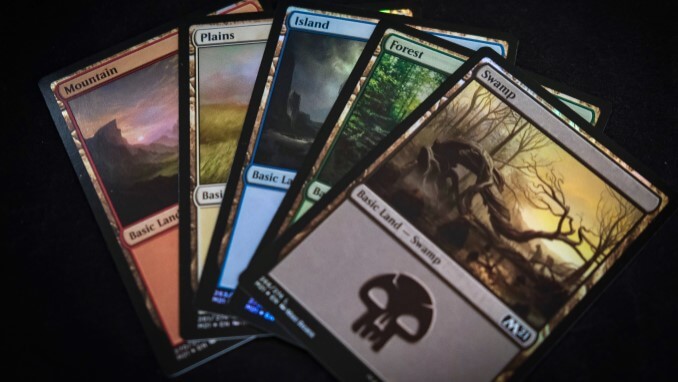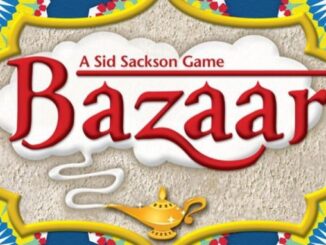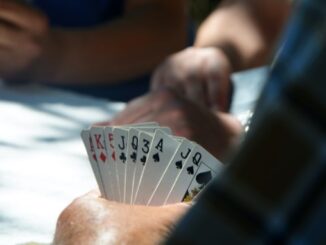
My earliest memories of playing games (other than the usual make-believe play that children do), is of sitting at a table, often at family gathering such as Christmas, birthdays and so on, with a deck (or two) of cards.
Both my parents and (both sets of) grandparents were keen card players, and also saw no reason not to include even very young children in the more ‘grown up’ games. I remember the ambivalent attitudes to gambling – that it was simultaneously very, very bad but also OK as long as it was only for pennies – a dispensation, that, I’m guessing, had to be made because several very enjoyable card games don’t really work without wagering.
So, I learnt very young to play Rummy, various flavours of Whist, Bezique, Canasta, Cribbage, Newmarket, Blackjack and Poker, and began a lifelong love of cards as tools for play.
A search in Ludogogy for cards reveals a wealth of articles celebrating this very versatility.
Now I work with games all the time, and that just reinforces, with each new mechanism I encounter, the versatility of cards as physical components to create an almost infinite variety of play experiences. This versatility comes from both the physical characteristics of the cards – the materials they are made from, their flatness, their two-sidedness and so on, and from the ‘content’ they hold, e.g. whether they are standard playing cards or some other type of card. The rest of this article is dedicated to exploring that versatility and to some games design challenges you might wish to try.
It necessarily just scratches the surface of what is possible, so please excuse if your favourite aspect of cards in play is not explored below. I have just tackled a manageable list. More will inevitably follow in other articles.
Standard playing cards
A pack of cards is a deceptively simple thing. Examining the concepts which underlie its design (or of conceptually similar objects like Mah Jong tiles) can reveal all sorts of possibilities for play. A few of these concepts are:
- Magnitude – cards have values which can be compared with each other (Snap), used in arithmetic (Blackjack), sequenced (Whist), matched (Go Fish), grouped (Rummy), form complex combinations, or combinations of combinations (Mah Jong)
- Suits – categories can facilitate grouping (Solitaire), Evaluation (Poker), powers (trump cards)
- Frequency and distribution – each card occurs just once in a deck, each suit has the same number of cards and each number occurs four times.
- Attribution – values or suits can be attributed special characteristics (wild cards), or actions (Crazy Eights)
- Narrative – more explicit in Tarot cards, but even ordinary playing cards can have meanings attached (dead man’s hand, cartomancy, ace of spades as bad luck)
- Etc.

Their design as physical objects affords several ways of using them:
- Revealed or hidden information – the two-sided design of cards means that their characteristics can be at any point in the game shown to or hidden from players, and furthermore that disclosure can apply to some players and not others
- Inclusion or exclusion – certain values or suits can be excluded from play, or play can be limited to small subset of cards (one’s hand)
- Randomisation – cards and tiles can be shuffled
- Their flatness allows them to be used as a surface and the shape of most playing cards allows them to be tessellated
- Etc.
In turn, the above facilitates all sorts of different play experiences. We are all familiar with cards being used to create experiences of Chance (Beggar my Neighbour) vs Skill (Gin Rummy), Bluffing (Poker), Competitive (Bezique) or Cooperative (Bridge) play and Gambling (Blackjack), but we can also include:
- Utilising skills in probability to gain advantage
- Card counting or other memory feats
- Map creation, or creation of other kinds of playing surface
- Changing the rules (Switch)
- Etc.
Games design challenges
- Take a standard pack of cards, and a theme (e.g. running a pizzeria, turning base metal into gold, opera singing, whatever). For the first set of bullet points list as many ways as you can think of that those concepts could support your theme. E.g. The suits of cards could represent components of a pizza, the values could represent different levels of skill in singing.
- Randomly choose three of four of the bullet points above (or concept within, if they have more than one example) and design a game. Try again with another set of bullet points if you want.
Pictures and text
Because cards are prime real estate for printed information, the sky is the limit when you use them as a way of introducing information into a game. Tarot cards, for example are primarily containers of imagery, but through symbolism and traditional metaphorical attributions they are rich in meaning.

Games such as Mysterium and Dixit use cards that are very similar to tarot decks to create play which incorporates narrative and player intuition. For those who are doubtful as they read this, I can recount a situation where I was asked to refrain from using Dixit cards, as prompts, in a learning setting, in case it upset religious people in the cohort.
Mysterium is available on Amazon.
There is inevitably overlap in the play experiences that are created by different types of cards, and my splitting this article into sections and themes is subjective and arbitrary, but the play experiences facilitated by image-based cards include:
- Interpretation (Tarot, Dixit)
- Narrative prompting
- Rebuses and other word play (Eyetoons)
- Matching and categorisation (Mysterium, Codenames Pictures)
- Creation of a session unique playing surface/layout (Tranquility)
- Supporting a game theme (Magic: The Gathering)
- Etc.
Tranquility (and the other games listed here) are available on Amazon.
Once words come into play, the possibilities are opened up even further. Text on cards can provide flavour, list powers or instructions that playing the card activates, provide information, keep score – the list is literally endless. Notable genre-creating (or busting) uses for text on cards over the past couple of decades include:
- Iterative additions of new game mechanics to an existing base game idea (Magic: The Gathering)
- Secret roles, hidden goals (Shamans, Secret Hitler)
- Cards as representations of complex multi-faceted entities such as projects (Terraforming Mars)
- Etc.
Terraforming Mars is available on Amazon.
Games design challenges
- Take any type of cards (other than standard playing cards), from a game that you own. List the experiences that they create in the game they are from (e.g. a Dixit card prompts a ‘clue’ sentence. It can (and the game relies on it) be interpreted differently by people with different life experiences – if I use the name of a TV show from the eighties as my clue, I can hopefully rely on my husband to ‘get’ it, but hide my meaning from my daughter. The card can be correctly matched to a clue or not)
- List the experiences that such a card COULD create but which is not used in the game it comes from. (e.g. the Dixit card could be sequenced with others to prompt the writing of a story, its significance could be in its colour rather than its image. It could be won in a ‘trick’ based on some criteria (number of objects in the image, or whatever).
- Create a game based on the ‘new’ experiences, but including none of the original ones.
Hidden and disclosed information
Cards are two-sided, a characteristic which can be exploited either to double the potential information (text or images) that a card can hold, or to create a ‘hiding’ mechanism by having a universally similarly ‘blank’ side for a deck. Hidden roles and secret goals as listed above are only two of the vast number of play experiences that this opens up.
- Hiding what resources are potentially available to all (draw pile) and available only to others (individual hands)
- Deduction (Love Letter)
- The game system itself hides information from all players (Cluedo)
- Hiding how well or badly you are doing (Settlers of Catan – hidden victory points on development cards)
- Etc.
Love Letter is available on Amazon.
Information on cards can be disclosed permanently in a game by turning them over, or temporarily by revealing them briefly before hiding them back e.g. in your hand. They can be disclosed to all or just to some. The size and portability of a card makes it ideal to be used in this way. Disclosure can facilitate the following play experiences:
- Asymmetry of information
- Gradual unfolding of narrative (Holding On: The Troubled Life of Billy Kerr)
- Changing the conditions or direction of the game (Fluxx)
- Making a move (Magic: The Gathering)
- Etc.
Holding On: The Troubled Life of Billy Kerr is available on Amazon.
Deckbuilding and set collection
The compact nature of cards, in relation to the information they can hold, and the size of the play experiences they can create, makes them ideal for creating games which can be constantly added to; which can become ‘collections’. This in turn, facilitates a situation where games can be played with a subset of a larger collection, and where new powers and mechanics can be added to an existing game easily. Collectible card games such as Magic: The Gathering demonstrate this well
Within play also, a large variety of cards with differing characteristics allows highly varied play within the same rule set. This can be seen particularly in Engine / Tableau Building games like Wingspan.
Wingspan is available on Amazon.
Play experiences which this allows includes:
- Extending the game backwards into an extensive planning/building stage (great for games-based learning around strategy
- Almost limitless combinations of actions to create previously unseen approaches to winning
- ‘Themed’ strategies
- ‘Puzzles’ to be solved, for which the solution is a particular combination of cards
- Etc.
Games design challenges
- Take some (random) cards from a collectible card game (Pokemon, MTG), list the many different powers / actions that they have.
- Alternatively use cards from a standard set of playing cards and assign a different power /action to each suit, value that you have in your selection. (e.g a club will compel your opponent to reveal their hand to you, a nine allows you to draw two new cards)
- Take subsets of the cards, and construct ‘strategies’ for winning based on those cards’ actions/powers. What would you call that strategy?
The future of cards
Although it seems like a bit of cheat, in an article about cards, written to a magazine theme of ‘Cardboard’, I would like to explore how cards are represented electronically in a new app called Deckible.
Full disclosure – I have two (at the time of writing) decks of my own in this app.
Deckible expands the above versatility of cards. Some of the things listed above which are advantages of the card format, can also be limitations. One of the most notable things that Deckible does is it removes the limitation of two sides. Deckible cards can have many sides, increasing the information they can hold.

A journalling feature means that you can interact with cards by writing about them. A timeline tracks and records all interactions with cards. Reflection and meditation is facilitated by a timer. Users are able to curate their own ‘superdecks’ using cards from decks that they own within the app.
Above all, Deckible prioritises portability. If you are a keen user of card decks, it can be challenging to carry them all around, not to mention that doing so might damage what can be beautiful, and expensive, objects. Deckible allows you to take your decks wherever you can take your phone.
Deckible will launch on September 16th, when it will be available on the Play Store and App Store. Until then you can browse the decks which will be available in the marketplace.
You can check out my own two decks, The Gift Horse and The Museum of Impossible Objects through my creator profile.
- James Bore – The Ransomeware Game - 13th February 2024
- Ipsodeckso – Risky Business - 23rd January 2024
- Review – Luma World Games - 15th December 2023





Be the first to comment